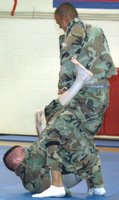 Read this discussion thread. I think it helps address the objects to groundfighting/BJJ on the battlefield, etc., and what the real purpose of the new Army FM is. I really appreciate this because I have had the same concerns and objections. Read my previous post. Excerpts:
Read this discussion thread. I think it helps address the objects to groundfighting/BJJ on the battlefield, etc., and what the real purpose of the new Army FM is. I really appreciate this because I have had the same concerns and objections. Read my previous post. Excerpts:On the purpose/objective of this type of combatives training:
... During our basic course, we introduce the concept of controlling the range during the standup fight by teaching them to achieve the clinch. Then, after showing them various aspects of controlling the clinch, we put the boxing gloves on and they have to achieve the clinch against someone who is trying to hit them. They soon learn that if you are tenacious, you don't get hit very much. Conversely, if you are timid, you get your butt handed to you. A film crew was in a couple of months ago on a day when we were doing ground grappling with strikes, also in the basic course. The students were doing randori with closed fist strikes to the body, and open palm strikes to the head. During all of this a female soldier got her nose smashed and came by the camera with blood all over her. The camera crew turned to me, asking "Do you get allot of injuries doing this type of training?" I answered that we often get black eyes, bloody noses, and fat lips, but that we want that sort of thing. The bottom line is, the defining characteristic of a warrior is the willingness to close with the enemy. That is our primary training objective.
On why striking is de-emphasized in the curriculum and combatives philosophy:
The comments about striking are as it relates to the modern battlefield. If you consider that a soldier with a broken hand is a casualty, and the likelihood of injuring yourself with any type of striking attack, not to mention an enemy with body armor etc, it makes less and less sense to have striking as your primary tool.
Answering whether WWII combatives were studied and how you measure the success of the program:
We have actually spent quite allot of time studying the WWII era combatives, and even farther back. The infantry center library has allot of material.
...When we started to evaluate combative systems, to be considered a success, a system had to have two characteristics. The average soldier had to know what the system designers said they should know, and the system had to produce its own experts. We have found that the techniques of a system are not the measure. It is whether or not the soldiers know them.
It is yet to be seen whether or not we will be successful, but compare the continued worldwide success of SOMBO to the small number of people who are studying WWII era Combatives. Ask yourself why for the last fifty years there has been only very limited combatives training in the Army. While I think the WWII era combatives was valuable and practical training, I also think that it was limited in its scope and vision. The system and techniques that are ideal for expanding an Army of a couple of hundred thousand into one of several million, are not necessarily the same as those that are the best for a large professional Army.

No comments:
Post a Comment